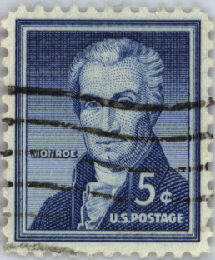FRtR > Outlines > American History (1990) > Chapter Four > Latin American Independence (4/9)
An Outline of American History (1990)
Chapter Four
Latin American Independence (4/9)
< Previous Page * Next Page >
The vision of liberty had stirred the people of Latin America
from the time the English colonies had gained their freedom.
Before 1821, Argentina and Chile had established their independence,
and in 1822, led by José de San Martin
and Simón Bolivar, other
South American states won freedom. By 1824, European colonies
remained only in the West Indies and on the northern coast of
South America.
 The people of the United States took a deep interest in what
seemed a repetition of their own experience in breaking away
from European rule. In 1822, President Monroe,
under powerful
popular pressure, received authority to recognize the new countries
- among them, Colombia, Chile, Mexico, and Brazil - and soon
exchanged ministers with them, thus recognizing these countries
as selfsustaining, genuinely independent, and entirely separated
from their former European connections.
The people of the United States took a deep interest in what
seemed a repetition of their own experience in breaking away
from European rule. In 1822, President Monroe,
under powerful
popular pressure, received authority to recognize the new countries
- among them, Colombia, Chile, Mexico, and Brazil - and soon
exchanged ministers with them, thus recognizing these countries
as selfsustaining, genuinely independent, and entirely separated
from their former European connections.
At just this point a number of central European powers
formed an association commonly called the Holy Alliance,
to protect themselves against revolution. By intervening in countries
where popular movements threatened the thrones of monarchs,
the Alliance hoped to prevent the spread of revolution into their
own dominions. This policy was the antithesis of the American
principle of selfdetermination.
< Previous Page * Next Page >
 The people of the United States took a deep interest in what
seemed a repetition of their own experience in breaking away
from European rule. In 1822, President Monroe,
under powerful
popular pressure, received authority to recognize the new countries
- among them, Colombia, Chile, Mexico, and Brazil - and soon
exchanged ministers with them, thus recognizing these countries
as selfsustaining, genuinely independent, and entirely separated
from their former European connections.
The people of the United States took a deep interest in what
seemed a repetition of their own experience in breaking away
from European rule. In 1822, President Monroe,
under powerful
popular pressure, received authority to recognize the new countries
- among them, Colombia, Chile, Mexico, and Brazil - and soon
exchanged ministers with them, thus recognizing these countries
as selfsustaining, genuinely independent, and entirely separated
from their former European connections.